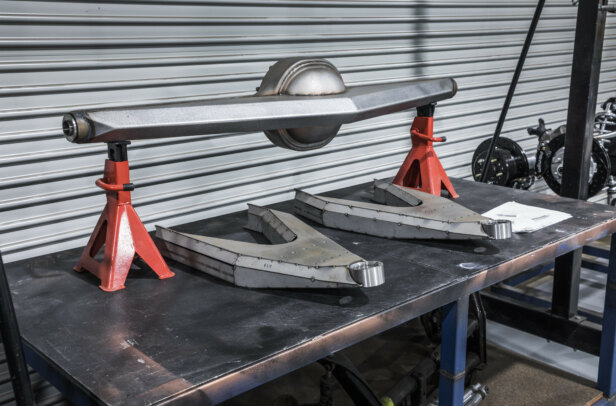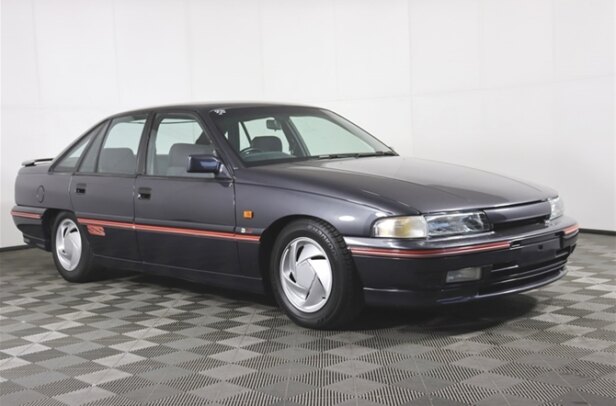Classic Aussie cars with wild body mods make our hearts sing, so we can’t wait to see this two-door XW wagon project hit the road.
This wagon has been in the build by Robi Fekete from Fekete Fabrications for a little while now, and the final result is looking like it’ll be a ground-breaking machine.
After lots of research, Robi determined that using the frameless doors and basic rear quarters from a 1966-67 Ford Ranchero would be the closest match to help build the two-door Falcon wagon Ford Australia never dreamed of.
“I didn’t want it to look odd as a two-door, so rather than just weld up the rear doors, we’ll completely reshape the car using the Ranchero stuff, as they have loosely the same body lines,” Robi says. “That’ll allow us to use longer doors, and moulding the rear quarters into the Falcon body will make it look like a factory car.”
The body mods won’t stop there, either. Robi plans to fit the wagon with a split tailgate, a roof-mounted centre console and a few other cheeky mods.
The suspension design Robi has come up with to fit the front airbags is particularly out there. “The front end was a tricky one to accomplish,” he says. “The fact that we wanted the car to lay out flat on the sills but also have a legal ride height of 100-115mm and the ability to still get up steep driveways made it a bit of a challenge.
“The main issue you face when airbagging an early Falcon or Mustang is that the chassis rails in relation to the outside of the car are very wide, meaning the distance from the rails to the outside of the car is very small.”
Robi says the process would’ve been easier with conventional coil-overs, but airbags were a must to achieve proper suspension travel and adjustability. “Travel with coil-overs is around 50-75mm, but we wanted approximately 175mm of travel, so we needed the airbags,” he says.
“To fit decent-length tubular control arms, spindle and airbag and a decent-width front tyre with a neutral type of wheel offset, all while fitting it around a Coyote engine, becomes almost impossible.”
Robi landed on a cantilever set-up with ShockWave-style air struts that house the airbag and dampener in one unit.
“We started with the steering rails, which are around 25mm narrower overall than the front rails. From there, we mocked up the steering rack, which dictates a lot of the front-end geometry,” Robi explains. “With that done, we fabricated the tubular control arms, front crossmember, suspension pick-up points and so on.
“With the front end done, we tried mounting the airbag in the conventional location on the lower control arm, but it physically didn’t fit,” he says.
Robi tried multiple ’bag locations, but creating an outrigger mount was an elegant solution that allowed full clearance for lock-to-lock steering along with full suspension travel. “It was also the only way I could still have room for turbos, radiator, intercooler, fluid coolers and so on at the front of the car,” he says.
“Between doing a bunch of maths and modelling in SolidWorks, we came up with three different cantilever arm designs and ended up going with the ones you see in the car. These arms have a leverage ratio of 1.7:1, and that, combined with the leverage ratio of 1.5:1 on the lower arm pivot point, got us the 175-180mm of suspension travel we were after.”
Every car Robi builds is 100 per cent engineered and street-legal. “To me, it’s not as challenging building a proper street car if it isn’t actually legal and conforming to some sort of regulation,” he says.
Like all the cars Robi builds, the XW will be fully engineered and on full Victorian rego. Looking at the scale of the mods, you could be forgiven for thinking that it would need to be done as an Individually Constructed Vehicle, which would mean that the car wouldn’t technically be a 1970s Ford anymore and be required to comply with current ADR regulations. Instead, Robi went the full rego route, which still required a stack of homework.
Before work on the XW began, Robi submitted his proposal for the car to VicRoads, and he consults with his engineer throughout the entire process. Starting the conversation early with both VicRoads and his engineer means less back-tracking during the build. “That starts a paper trail with both the engineer and VicRoads confirming that I can build the car as intended, with myself, the engineer and VicRoads all on the same page,” he says.
“Because the original VIN number on the radiator support wasn’t going to be modified or removed, the identity of the car remains intact. The basic silhouette of the car will also remain even with the two-door shape, so as my engineer says, if it looks like a duck and talks like a duck, it can be registered as a duck.”
With so much of the car’s structure modified, the testing procedures for the XW will be extensive. “The car will be torsion tested, which basically involves twisting the entire car on a jig to determine its torsional rigidity in comparison to the factory vehicle,” says Robi. “We’ll also have to go through noise pollution testing, suspension load testing (both digitally modelled and physical), tear-off calculations on all components, brake testing, swerve testing, suspension travel tests and so on. As you can imagine, it’s a very long process.”
So why does he go through all the effort? “Because it makes you push yourself further, and delivering what we do while having it be completely legal is very satisfying,” Robi states. “I don’t even bother these days with my own project cars, as I get to see out my visions with customers’ projects, and I’ve constantly got new ideas floating around for what to do next.”




Comments